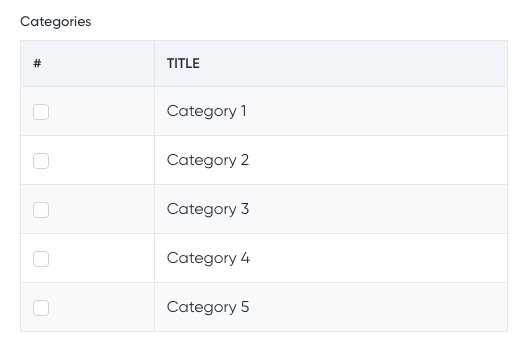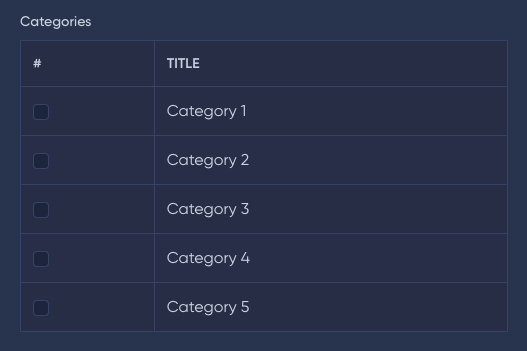At MoonShine, we believe that great documentation isn’t just a nice-to-have — it’s the foundation of our product. It’s what helps beginners get started with confidence and allows experienced developers to move faster and smarter.
We aim to write in clear, simple language, avoiding internal jargon and overly complex explanations. Whenever possible, we highlight each section with real-world use cases and screenshots — because theory is great, but practical examples are better.
That said, great documentation is hard. It takes time, care, and ongoing effort. But we’re committed to the process. With every release, we strive to make our docs a little clearer, more helpful, and more accessible for everyone building with MoonShine.
The section title is the first and mandatory element of the page.
# TitleIf the section is large, it should be divided into subsections and a navigation menu should be created.
The navigation menu is a list with links to the subsection. The subsection headings should have an anchor specified.
- [Subtitle 1](#subtitle-1)
- [Subtitle 2](#subtitle-2)Note
Kebab-case is used to separate words in links.
After navigation (content), a divider should be specified.
---
Subsection headings are specified with a link for easy copying of the link to a specific section of the documentation.
## SubtitleIf Navigation is used, an anchor should be added before the heading:
<a name="anchor"></a>
## SubtitleFor the name of the first item, it is often necessary to use the name Basics, instead of similar Start, Introduction, etc.
<a name="basics"></a>
## BasicsIf a component is described that inherits from another class, and there is a Basics item in the navigation,
then the description of inheritance is written strictly after this item.
<a name="basics"></a>
## Basics
Inherits from [Select](/docs/{{version}}/fields/select).
\* has the same capabilities.If the basic methods are described in another section of the documentation, then write it like this
<a name="basics"></a>
## Basics
Contains all [Basic methods](/docs/{{version}}/fields/basic-methods).In addition to markdown tags, html-tags are allowed.
Warning
All sentences should end with a period.
It is desirable to synchronize the texts in the ru and en versions of the sections line by line.
Double asterisks ** are used to format proper name, for example, **MoonShine**.
- single apostrophe
`is used to format methods, classes, etc., - method names should end with parentheses, for example:
setLabel(), - triple apostrophes
```with the programming language specified are used to format code blocks, and the block should start on a new line, - for all classes used in examples, you need to specify use in alphabetical order and wrap them in collapse.
// torchlight! {"summaryCollapsedIndicator": "namespaces"}
// [tl! collapse:1]
use MoonShine\UI\Fields\Text;
Text::make('Title')or
// torchlight! {"summaryCollapsedIndicator": "namespaces"}
// [tl! collapse:start]
use MoonShine\UI\Fields\Text; // [tl! collapse:end]
Text::make('Title')If you need to specify what changes in the code, then you can use a special design.
MenuItem::make('Settings', new SettingResource(), 'heroicons.outline.adjustments-vertical') // [tl! remove]
MenuItem::make('Settings', SettingResource::class, 'adjustments-vertical') // [tl! add]or
MenuItem::make('Settings', new SettingResource(), 'heroicons.outline.adjustments-vertical') // [tl! --]
MenuItem::make('Settings', SettingResource::class, 'adjustments-vertical') // [tl! ++]You can specify the name of the file or class to which the code belongs using the filename parameter.
```php filename:config/moonshine.php
Warning
Spaces in names are not allowed.
- list items end with a comma,
- a dot is placed after the last one.~~~tabs
tab: Tab 1
Content tab 1
tab: Tab 2
Content tab 2
~~~
The documentation uses several types of alerts:
> [!NOTE]
> Simple notification.
> [!WARNING]
> Warning.
> [!TIP]
> Tips.
Images are added to the /resources/screenshots directory.
The link is specified - https://raw.githubusercontent.com/moonshine-software/doc/3.x/resources/screenshots/filename.png
Example:

To show the image in a dark or light themes, you must add to the link hashtag #light or #dark.


The shortcode include connects markdown and renders it, and then runs the content through sprintf, so all parameters after the path to markdown will be passed in the same order.
@include($path_to_md, ...$params)_includes/my-partial.md
## Hello world
%s - %s_includes/test.md
<a name="what-is-moonshine"></a>
## What is MoonShine
@include('_includes/test', 'test', 3)sprintf('markdown', 'test', 3);<h2>What is MoonShine</h2>
test - 3
